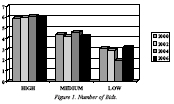
Fall 2006
INDIANA CONSULTING FORESTERS STUMPAGE TIMBER PRICE REPORT
Provided courtesy of the Indiana Association of Consulting Foresters.
This stumpage report is provided on a semi-annual basis and should be used in association with the Indiana Forest Products Price Report and Trend Analysis written by Dr. William Hoover in cooperation with Indiana's forest products companies. Dr. Hoover's report is published in the Winter issue of the Woodland Steward Newsletter.
Stumpage price was obtained via a mail survey to all known professional consulting foresters operating in Indiana. Reported prices are for sealed bid timber sales only (not negotiated sales) between a motivated timber seller and a licensed Indiana timber buyer. The data represents approximately 10 to 15 percent of the total volume of stumpage purchased during the periods from August 16, 2005 through August 15, 2006.
The results of this stumpage price survey are not meant as a guarantee that amounts offered for your timber will reflect the range in prices reported in this survey. The results simply provide an additional source of information to gauge market conditions. The sealed bid timber sale process is for trees marked by a professional forester. The species, number of trees and volume in a sealed bid sale are determined prior to the notice of sale. A notice is sent to licensed timber buyers who then inspect the timber then offer a price for said trees at a predetermined time and place. Under conditions determined in the bid notice, the owner then accepts or rejects the bids. Upon acceptance of the bids by the owner and fee paid , the owner then conveys the right to cut the advertised trees to the purchaser. This is frequently referred to as a lump sum timber sale.
This report reflects “spot market” prices, not the average price paid by timber buyers. The bidding process used by consultants “spots” the maximum amount any buyer is willing to pay for a particular lot of timber at a particular time and place, not the average price paid for timber. High bids frequently reflect an urgent need for timber because of special orders for lumber or veneer, low log inventories at the buyer's mill, poor logging conditions due to wet weather, or other special conditions.
Hardwood lumber is sold in a highly competitive commodity market. Competition comes from mills within the state, region, and hardwood lumber producers in the Lake States, Northeast, South and Southeastern production areas. This market competition means that the cost of stumpage in other producing regions determines in part the amount Indiana mill and loggers can pay for stumpage. If all timber were sold on a bid basis the spot market would no longer exist and the average of the highest bid price offered would be lower than now observed. This explanation isn't meant to deter you from seeking the best available price. It's meant to explain the apparent discrepancy between the two price reporting systems.

SEALED BID PRICES The prices reported are broken into three sale types; high quality, average quality, and low quality. A high quality sale is one where more than 50 percent of the volume is number 2 grade or better red oak, white oak, sugar maple, white ash * (see below), black cherry, or black walnut. The average sale is considered one that is not a low quality sale. The low quality sale has more than 70 percent of the volume in number 3 grade or is cottonwood, beech, hickory, elm, sycamore, hackberry, pin oak, aspen, black gum, black locust, honey locust, catalpa, or sweet gum.
A total of 269 sales were reported for the twelve month period ending in August. Figure 1 shows the number of sealed bid offered by sale type. A total of 1280 bids were received for the 269 sales. The figure also reflects what foresters have been suggesting, higher quality timber offered for sale increases buyer interest and the number of bids offered. This number has been fairly consistent since this survey began in 1999-2000. The average number of bids offered per sale was 4.76 for this period, with 5.97 bids / high quality sale, 4.17 bids / average quality sale, and 3.16 bids / low quality sale. A total Doyle stumpage volume of 25,570,553 board feet was sold during this period. The average volume per sale was 93,702 board feet for high quality, 103,209 board feet for average quality, and 78,355 board feet for low quality. Total timber value sold was $ 10,857,268. Average value by type was $ 6,005,210, $ 4,095,499, and $ 756,559, respectively. The weighted average of the stumpage price by sale type (obtained from this survey in 2000, 2002, 2004, and 2006) is reported in Figure 2.
The weighted average of the stumpage price is the total value ($) for each sales group (high, average, low) divided by the total volume by sales group. The median stumpage price by sale type per year is reported in figure 3. The median price is the amount where half of the sales are higher and half are lower. The price reported is per 1000 board feet (MBF) of standing timber. To obtain a price per board foot, divide the price by 1000. An average price of $567 per thousand (MBF) is the same as 56.7 cents per board foot stumpage. The average stumpage price for high quality sale was $ 567/MBF, $357/MBF for average quality, and $215/MBF for low quality. Price ranges by sale type are reported in Figures 4 - 6.
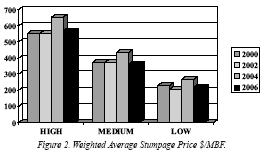
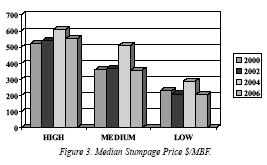
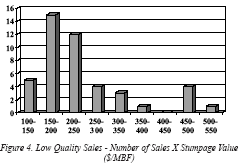
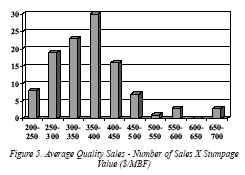
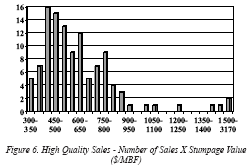
Below is a statistical summary for all three sale types.
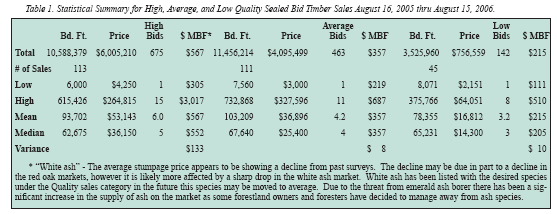
The comment section below is offered to our readers by the consulting foresters who participated in this survey.
• “Prices paid for red oak are off enough in northern Indiana that we are delaying the sales with significant amounts until prices improve.”
• “White ash prices are way down because of increased supply due to emerald ash borer issues and soft lumber markets. Don't anticipate seeing much of an increase for quite some time”
• “The markets have been generally steady throughout the period. Walnut remains strong and red oak remains depressed”
• “Walnut and white oak markets are excellent. Tulip, hickory, cherry and sugar maple markets are good. Quality red oak markets are good with medium quality red oak markets being fair. Ash market is poor due to over supply due to heavy selling because of emerald ash borer threat, which will probably continue for many years. Low quality, crating / pallet markets only fair.
When selling timber, good terms such as sufficient logging time, payment terms, and yarding size and locations (year round access) is very important in getting interested buyers and receiving a good price.”